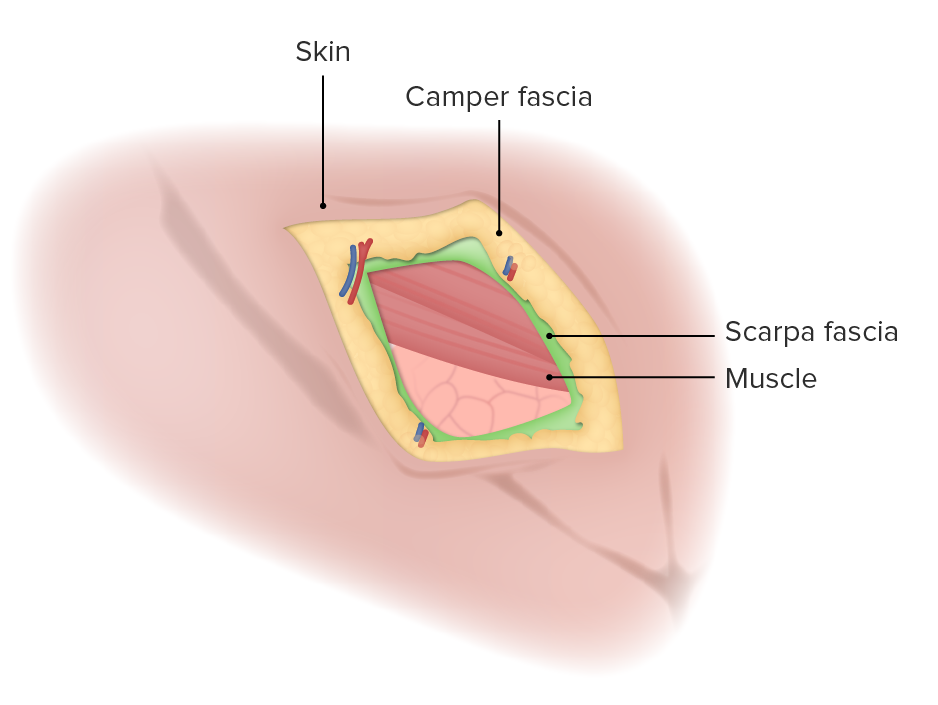Playlist
Show Playlist
Hide Playlist
Abdominal Regions and Reference Planes
-
Slides Abdominal Regions and Reference Planes.pdf
-
Reference List Anatomy.pdf
-
Download Lecture Overview
00:01
So now, let's have a look at some
abdominal regions
and the various planes that are
used to describe those regions.
00:08
So, here we are again looking
at the anterolateral abdominal wall.
00:12
And we can imagine a
transverse plane
that's going across the abdomen.
00:16
And this one is situated
the inferior aspect
of those costal cartilages
that we described previously.
00:23
This is the subcostal plane.
00:25
We also have a
transtubercular plane,
and this runs again transversely
across the abdomen,
from each iliac tubercle
on the superior aspect
of the iliac part
of the pelvic bone.
00:37
You can see here
that it can then split up
the abdomen into three regions.
00:42
The epigastrium which is located
superior to the subcostal plane.
00:47
The mesogastrium which is situated
between the subcostal
and the transtubercular plane.
00:52
And then, inferiorly,
we have the hypogastrium,
and this is situated inferior
to the transtubercular plane.
01:00
We can then add to
what are known as
paramedian or midclavicular lines.
01:06
And these run down in that
paramedian plane.
01:09
You can see there.
01:10
And that very
nicely separates
the three areas into nine regions.
01:16
So now we can see these
one through to nine.
01:19
Here in the top right hand aspect,
we can see we have
the right hypochondriac region.
01:26
We then have the epigastric region,
and then we have
the left hypochondriac region.
01:32
So these are situated all above
the subcostal plane
which is now separated into
those three.
01:37
We have the left hypochondriac,
we have the epigastric,
and we have the right
hypochondriac region.
01:44
So we can see those
positioned on the screen.
01:47
Then if we look in the
middle aspect,
we have the right lateral region,
we have the umbilical region,
where you can see the umbilicus.
01:55
and we have the
left lateral region.
01:58
Then most inferiorly,
we have the right inguinal region,
We'll come to that in
much more detail later on.
02:04
We have the pubic region.
02:06
And then similarly, we have
the left inguinal region as well.
02:10
So left inguinal, the pubic region,
and the right inguinal.
02:14
We can see these three areas
we described previously.
02:18
Now being split into
those nine regions.
02:21
That's important when you're
helping to describe
which organ or which area
of the surface
of the abdomen
may have a lesion or a marking.
02:30
And it helps to describe
that location.
02:32
And everyone is unfamiliar
using those terms
where you are talking about.
02:38
We spoke about splitting
into nine regions.
02:40
We can also talk
about four quadrants.
02:42
This time,
we look at the median plane,
which is running right down the
midline of the body.
02:48
So following the xiphisternum,
of the xiphoid process
on the inferior aspect
of the sternum,
all the way down to the
pubic symphysis.
02:55
We can see it splitting the body
into left and right halves.
02:58
We can then,
we have a horizontal line
or transverse kind of line
going through the umbilicus there.
03:04
You can see, we've split
the anterior abdominal wall
into these four quadrants.
03:10
We now have the
right upper quadrant,
the left upper quadrant.
03:15
We have the right lower quadrant,
and we have the left lower quadrant.
03:21
And you can see those
four quadrants now on the screen.
03:26
As I mentioned a
moment or two ago,
the position of the organs
can now be located
within each of those quadrants
or in those regions.
About the Lecture
The lecture Abdominal Regions and Reference Planes by James Pickering, PhD is from the course Surface Anatomy of the Abdomen.
Included Quiz Questions
Which costal cartilage does the subcostal plane pass through?
- 10
- 9
- 8
- 12
- 11
Customer reviews
5,0 of 5 stars
| 5 Stars |
|
5 |
| 4 Stars |
|
0 |
| 3 Stars |
|
0 |
| 2 Stars |
|
0 |
| 1 Star |
|
0 |




